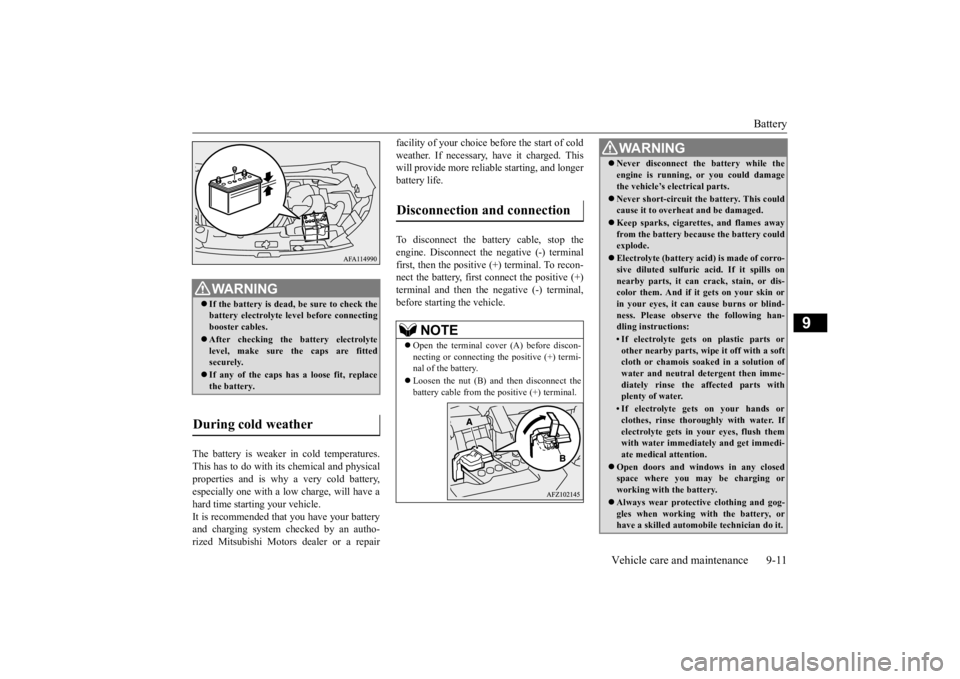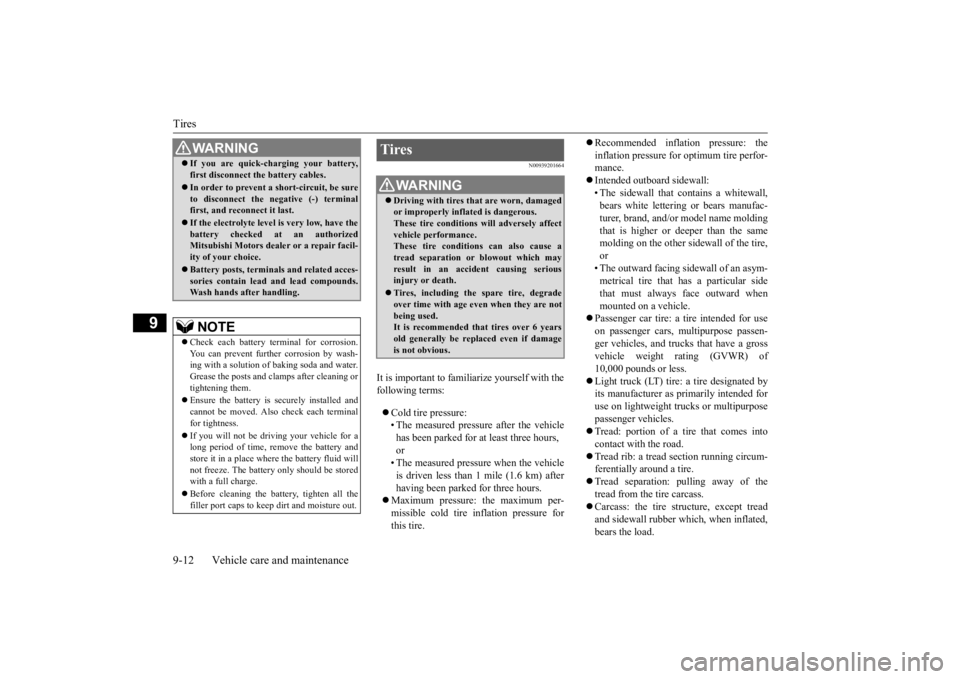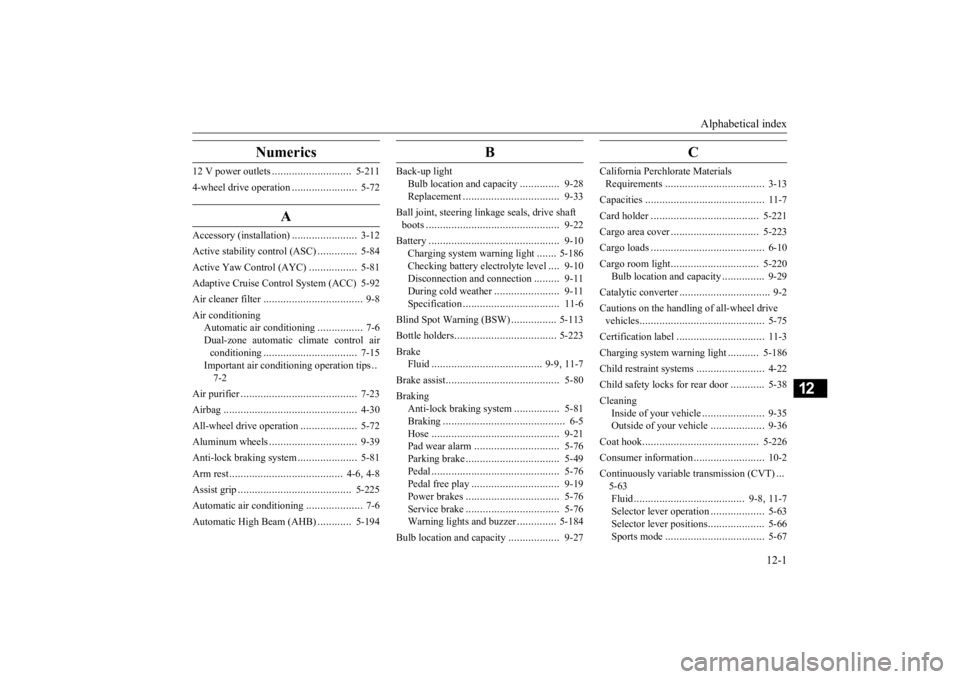charging MITSUBISHI ECLIPSE CROSS 2020 (in English) User Guide
[x] Cancel search | Manufacturer: MITSUBISHI, Model Year: 2020, Model line: ECLIPSE CROSS, Model: MITSUBISHI ECLIPSE CROSS 2020Pages: 427, PDF Size: 78.05 MB
Page 376 of 427

Battery
Vehicle care and maintenance 9-11
9
The battery is weaker in cold temperatures. This has to do with its chemical and physical properties and is why a very cold battery, especially one with a low charge, will have ahard time starting your vehicle. It is recommended that you have your battery and charging system checked by an autho-rized Mitsubishi Motors dealer or a repair
facility of your choice before the start of cold weather. If necessary, have it charged. This will provide more reliable starting, and longer battery life. To disconnect the battery cable, stop the engine. Disconnect the negative (-) terminalfirst, then the positive (+) terminal. To recon-nect the battery, first connect the positive (+) terminal and then the negative (-) terminal, before starting the vehicle.
WA R N I N G If the battery is dead, be sure to check the battery electrolyte level before connecting booster cables. After checking the battery electrolyte level, make sure the caps are fitted securely. If any of the caps has a loose fit, replace the battery.
During cold weather
Disconnection and connection
NOTE
Open the terminal cover (A) before discon- necting or connecting the positive (+) termi- nal of the battery. Loosen the nut (B) and then disconnect the battery cable from the positive (+) terminal.
WA R N I N G Never disconnect the battery while the engine is running, or you could damage the vehicle’s electrical parts. Never short-circuit the battery. This could cause it to overheat and be damaged. Keep sparks, cigarettes, and flames away from the battery because the battery could explode. Electrolyte (battery acid) is made of corro- sive diluted sulfuric
acid. If it spills on
nearby parts, it can crack, stain, or dis-color them. And if it gets on your skin or in your eyes, it can cause burns or blind- ness. Please observe the following han-dling instructions:• If electrolyte gets on plastic parts orother nearby parts, wi
pe it off with a soft
cloth or chamois soaked in a solution of water and neutral detergent then imme-diately rinse the affected parts with plenty of water.• If electrolyte gets on your hands orclothes, rinse thoroughly with water. If electrolyte gets in your eyes, flush themwith water immediately and get immedi- ate medical attention.
Open doors and windows in any closed space where you may be charging or working with the battery. Always wear protective clothing and gog- gles when working with the battery, or have a skilled automobile technician do it.
BK0277700US.bo
ok 11 ページ 2019年3月8日 金曜日 午前9時23分
Page 377 of 427

Tires 9-12 Vehicle care and maintenance
9
N00939201664
It is important to familiarize yourself with the following terms: Cold tire pressure: • The measured pressure after the vehicle has been parked for at least three hours,or • The measured pressure when the vehicle is driven less than 1 mile (1.6 km) afterhaving been parked for three hours.
Maximum pressure: the maximum per- missible cold tire inflation pressure forthis tire.
Recommended inflation pressure: the inflation pressure for optimum tire perfor- mance. Intended outboard sidewall: • The sidewall that contains a whitewall, bears white lettering or bears manufac- turer, brand, and/or model name moldingthat is higher or deeper than the same molding on the other sidewall of the tire, or• The outward facing sidewall of an asym-metrical tire that has a particular side that must always face outward when mounted on a vehicle.
Passenger car tire: a tire intended for use on passenger cars,
multipurpose passen-
ger vehicles, and trucks that have a grossvehicle weight rating (GVWR) of 10,000 pounds or less. Light truck (LT) tire: a tire designated by its manufacturer as primarily intended for use on lightweight trucks or multipurpose passenger vehicles. Tread: portion of a tire that comes into contact with the road. Tread rib: a tread section running circum- ferentially around a tire. Tread separation: pulling away of the tread from the tire carcass. Carcass: the tire structure, except tread and sidewall rubber which, when inflated, bears the load.
If you are quick-charging your battery, first disconnect the battery cables. In order to prevent a short-circuit, be sure to disconnect the negative (-) terminalfirst, and reconnect it last. If the electrolyte level is very low, have the battery checked at an authorized Mitsubishi Motors dealer or a repair facil- ity of your choice. Battery posts, terminals and related acces- sories contain lead and lead compounds.Wash hands after handling.NOTE
Check each battery terminal for corrosion. You can prevent further corrosion by wash- ing with a solution of baking soda and water.Grease the posts and clamps after cleaning or tightening them. Ensure the battery is securely installed and cannot be moved. Also check each terminal for tightness. If you will not be driv
ing your vehicle for a
long period of time, remove the battery and store it in a place where the battery fluid will not freeze. The battery only should be storedwith a full charge. Before cleaning the battery, tighten all the filler port caps to keep dirt and moisture out.WA R N I N G
Tires
WA R N I N G Driving with tires that are worn, damaged or improperly inflated is dangerous. These tire conditions will adversely affect vehicle performance.These tire conditions can also cause a tread separation or blowout which may result in an accident causing seriousinjury or death. Tires, including the spare tire, degrade over time with age even when they are not being used. It is recommended that tires over 6 yearsold generally be replaced even if damage is not obvious.
BK0277700US.bo
ok 12 ページ 2019年3月8日 金曜日 午前9時23分
Page 420 of 427

Alphabetical index
12-1
12
Numerics
12 V power outlets
............................
5-211
4-wheel drive operation
.......................
5-72
A
Accessory (installation)
.......................
3-12
Active stability control (ASC)
..............
5-84
Active Yaw Control (AYC)
.................
5-81
Adaptive Cruise Control System (ACC) 5-92Air cleaner filter
...................
................
9-8
Air conditioning
Automatic air conditioning
................
7-6
Dual-zone automatic climate control air conditioning
................
.................
7-15
Important air conditioning operation tips
..
7-2
Air purifier
....................
.....................
7-23
Airbag
.......................
........................
4-30
All-wheel drive operation
....................
5-72
Aluminum wheels
...............................
9-39
Anti-lock braking system
.....................
5-81
Arm rest
.....................
...................
4-6
, 4-8
Assist grip
.....................
...................
5-225
Automatic air conditioning
....................
7-6
Automatic High Beam (AHB)
............
5-194
B
Back-up light
Bulb location and capacity
..............
9-28
Replacement
...................
...............
9-33
Ball joint, steering linkage seals, drive shaft boots
.........................
......................
9-22
Battery
........................
......................
9-10
Charging system warning light
.......
5-186
Checking battery electrolyte level
....
9-10
Disconnection and connection
.........
9-11
During cold weather
.......................
9-11
Specification
...................
...............
11-6
Blind Spot Warning (BSW)
................
5-113
Bottle holders
...................
.................
5-223
Brake
Fluid
....................
...................
9-9
, 11-7
Brake assist
......................
..................
5-80
Braking
Anti-lock braking system
................
5-81
Braking
.......................
....................
6-5
Hose
.......................
......................
9-21
Pad wear alarm
...............
...............
5-76
Parking brake
..................
...............
5-49
Pedal
.......................
......................
5-76
Pedal free play
................
...............
9-19
Power brakes
..................
...............
5-76
Service brake
..................
...............
5-76
Warning lights and buzzer
..............
5-184
Bulb location and capacity
..................
9-27
C
California Perchlorate Materials Requirements
..................
.................
3-13
Capacities
.....................
.....................
11-7
Card holder
...................
...................
5-221
Cargo area cover
................
...............
5-223
Cargo loads
...................
.....................
6-10
Cargo room light
................
...............
5-220
Bulb location and capacity
...............
9-29
Catalytic converter
................
................
9-2
Cautions on the handling of all-wheel drive vehicles
.......................
.....................
5-75
Certification label
...............................
11-3
Charging system warning light
...........
5-186
Child restraint systems
........................
4-22
Child safety locks for rear door
............
5-38
Cleaning
Inside of your vehicle
......................
9-35
Outside of your vehicle
...................
9-36
Coat hook
......................
...................
5-226
Consumer information
.........................
10-2
Continuously variable transmission (CVT)
...
5-63 Fluid
..................
.....................
9-8
, 11-7
Selector lever operation
...................
5-63
Selector lever positions
....................
5-66
Sports mode
..................
.................
5-67
BK0277700US.bo
ok 1 ページ 2019年3月8日 金曜日 午前9時23分